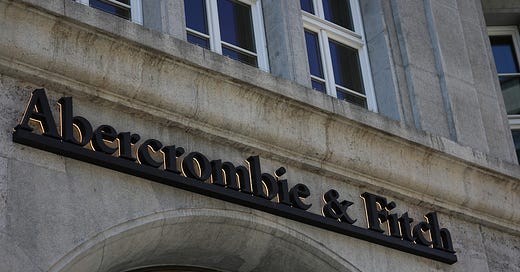Abercrombie Has Changed, But Some Things May Stay The Same
Abercrombie & Fitch made a major change in its branding. Is it enough?


“Wait, Abercrombie is actually cute?” read a recent text I received from a friend. She, like many other millennials including myself, had recently watched Netflix’s Abercrombie & Fitch exposé, White Hot: The Rise & Fall of Abercrombie & Fitch. The film highlights how behind the brand’s massive rise was built on a culture of exclusion on every level of the business. The revelations in the doc weren’t surprising to me in the least, because, well, I worked there in high school. It was very much a side job that I had been recruited for, but even in the few dreadful months I spent one summer standing in the front folding tiny t-shirts, it was clear just how toxic the culture was. Plus, the clothes were not my style – the only thing I owned was a little gray zip up that I wore all the time.
But that was 2006, and times have changed — at least aesthetically. The brand has moved on from the ripped jeans and logo shirts that made it famous and has rebranded completely, using a cross-generational strategy that is attempting to appeal to millennials. I’ll admit it, I was shocked how many bodysuits and sweater sets I found myself wanting to add to cart when I researched the brand after watching. The same went for many of my 30-something friends who were decidedly not part of the A&F demo in the past, but who are now texting me asking why they want to shop there.
The documentary touched on this a little, but the reason for this shift is that when the former CEO Mike Jeffries left, a new CEO, Fran Horowitz, came in and did a complete overhaul. In a post on the company website, she said she changed it “into a place of belonging.” She went on to add: “We’ve evolved the organization, including making changes in management, prioritizing representation, implementing new policies, re-envisioning our store experiences and updating the fit, size-range and style of our products.” Hence me and all my friends questioning why we want to buy Abercrombie dresses for the summer.
The thing is, there is always a catch, and I’m pretty sure that’s why I received that half announcement, half question text message one afternoon. Just because the prices are not cheap and there have been commitments to change on a cultural level doesn’t mean Abercrombie & Fitch is past their fast fashion roots. They still operate on a multi-seasonal level, switching out new styles online and in hundreds of stores, often to keep up with ever-evolving trends. Also, despite supposed plans to become more ethical and sustainable, the brand scored significantly lower than other fast fashion brands on Fashion Revolution’s Transparency Index. In many key areas, including traceability, governance, and know, show, and tell, the score was under the 30% range. They did score a bit higher in commitments — however, as recently as May 2022, they refused to sign the Bangladesh Accord, an agreement that guarantees worker safety in garment factories.
So with all this in mind, how did I answer that text? Well, for starters, I would say that yes, it IS really cute - I’ll admit I recently found overalls new with tags on resale and they are great. But in terms of overall sustainability, it’s not great yet. So if that’s something you are concerned with (and I hope most of us are), it’s probably not the brand for you right now. I do think they have the potential to move in the right direction, though. The CEO at least appears to care about the public backlash to bad ethics, and so it might be worth it to sign this petition asking them to make commitments that not only look good on the website, but to also take accountability and make immediate changes to improve things for their workers across the board, not just in retail.
Wherever you shop and for whatever reason, I think it’s good to have the whole picture and be an informed consumer. Do you need that body suit? Probably not. If you’re going to buy it though (I’m realistic about the way people shop), pay attention to the quality and fit so that it’s something you can have for a long time. And know that there are actions you can also take to get the company to work harder for your dollar and protect the person that made it.
*****************************************************************************
Thank you for reading!!
This Stuff is a newsletter by me! fashion journalist, Alyssa Hardy. Three times a week, I unpack the ways our clothes impact the world through news, essays, interviews and more. Subscribe for free here and follow me on Instagram, Facebook and Twitter.
You can preorder my book "Worn Out: How Our Clothes Cover Up Fashion's Sins" here.




